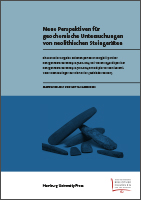Neue Perspektiven für geochemische Untersuchungen von neolithischen Steingeräten. Ein Methodenvergleich zwischen portabler energiedispersiver Röntgenfluoreszenzanalyse (P-ED-RFA) und wellenlängendispersiver Röntgenfluoreszenzanalyse (WD-RFA) am Beispiel von bandkeramischen Dechselklingen aus Diemarden (Südniedersachsen)
Author(s)
Ramminger, Britta
Helfert, Markus
Collection
AG UniverlageLanguage
GermanAbstract
Shoe-last celts (Dechselklingen) are characteristic legacies of the -iddle European Old and Middle Neolithic. They are important sources of economic and social archaeological investigations. This requires the determination of the used raw materials and their origin. In recent years, extensive geochemical and petrographic investigations of interchangeable blades have been carried out. Within the scope of various projects, a database with geochemical analyses of wmuch more than 500 blades and raw material pieces has been created. The analyses were all generated by wavelength dispersive X-ray fluorescence analysis (WD-RFA). The petrographic and geochemical examination was always accompanied by a sampling of the investigated pieces, which resulted in more or less severe damage to the artifacts. The portable energy dispersive X-ray fluorescence analysis (P-ED-RFA), which has recently been used in archaeometric ceramic analysis, can non-destructiveally determine the geochemical composition of vascular ceramics. In contrast to all the methods used so far, the sample does not have to be prepared in the laboratory, but can be carried out directly on site in a relatively short time. Thus, a time- and thus cost-effective procedure is available.
Keywords
shoe-last celts; Pre- and early history; stone tools; interchangeable blades; Lower Saxony; X-ray fluorescence analysis; P-ED-RFA; WD-RFADOI
10.15460/HUP.129ISBN
9783943423051OCN
1083021966Publisher
Hamburg University PressPublication date and place
Hamburg, 2012Classification
History


 Download
Download Web Shop
Web Shop